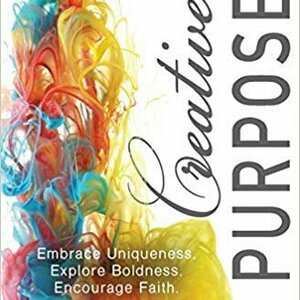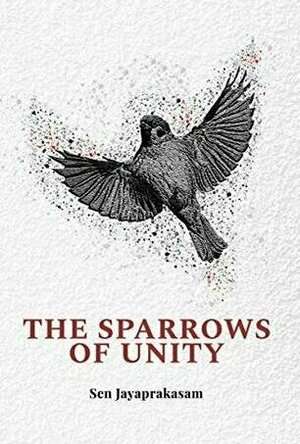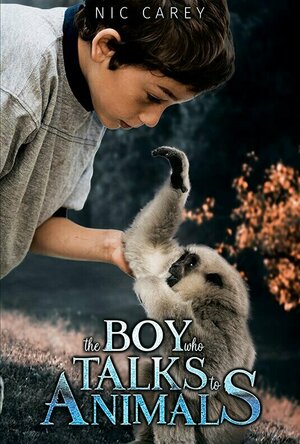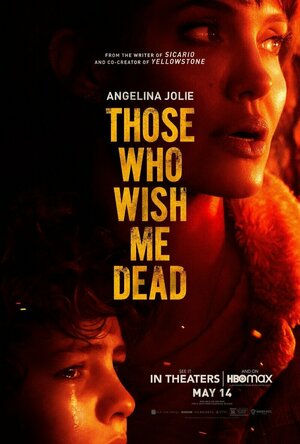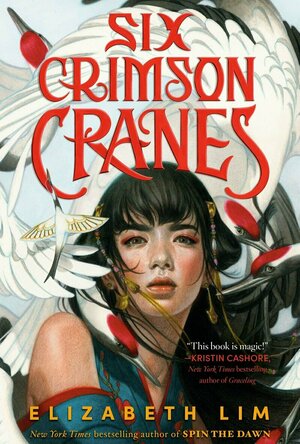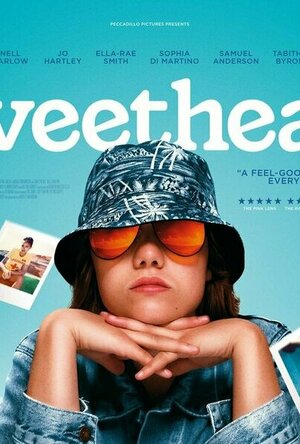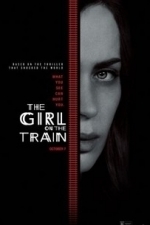Search
Search results
What might be sabotaging your uniquely gifted contribution to the world around you? Discover the obstacles and barriers standing between you and your God-given purpose. In this revised book, youll learn how to identify ways to strengthen your calling thatll encourage you to confidently operate in the gifts and talents that God designed you to do. Through the lens of T.H. Meyers own journey, youll recognize the universal struggle in embracing your whole person as she encourages you to live a life without regrets. For the individual reader looking to examine more deeply their life purpose or a group seeking to collectively spur each other toward their God-given gifts, talents, and life. This book can be used as a 12-week, 6-week, or 4-week study guide, with exploratory questions at the end of each chapter the assist you in listening to Gods voice and revealing your unique purpose, path, or direction.
Endorsements A wonderful exploration, but not only for readers to look inwardly, but to also look around at others, at where our lives are at, and mostly upward toward Gods design and dreams for our lives. Love it! Cindy Coloma, best selling and award-winning author of over 15 books Youll come away from this wise and insightful book with a clearer understanding of how you are uniquely gifted to contribute to the world, and why its imperative that you honor your creative calling. Michelle DeRusha, author of Katharina and Martin Luther: The Radical Marriage of a Runway TH Meyer looks at the glass ceiling the world has placed between creatives and non-creatives and shatters it. This those who have felt they are not creative, too timid, or simply too late to the life they were called to live, Meyer says, Pish-posh. She delivers on her promise to help people embrace uniqueness, explore boldness, and encourage faith. Amy Young, author of Looming Transitions: Starting & Finishing Well in Cross-Cultural Service In her book, A Life Of Creative Purpose, Tammy Hendricksmeyer [TH Meyer] is a trusted mentor, offer ing us the tools we need to step completely into Gods design for us as individuals, and as members of His body. Her relatable stories coupled with scripture inspire and ignite a renewed passion for pursuing not only our own creative callings but even more, her words stoke the fire in our hearts for the Giver of these gifts. Kris Camealy, author of Come, Lord Jesus: The Weight Of Waiting A Life of Creative Purpose is a fantastic resource filled with thoughtful questions, stories, and Scripture each designed to awaken us to Gods unique purposes for our lives. It is well-written, thoughtful, and engaging, an invitation to embrace our own eternally significant creative purpose. Cindee S. Re, author of Discovering Hope: Beginning the Journey Toward Hope in Chronic Illness In her book, A Life of Creative Purpose, TH Meyer masterfully blends personal stories with wisdom from Scripture to reveal the importance of creative purpose (even if you think you are not creative.) The thought-provoking questions at the end of each chapter will help you discover (or uncover) and embrace the unique way God has made you and inspire you to step into a life of purpose, meaning, and fulfillment. JoDitt Williams, author/artist of Delight in the Word of God: A Devotional Coloring Book/Journal for Adults
My Thoughts: This is a great book to remind us about the gifts that God has for each of us. It reminds us not to be afraid to step out in faith to use the guts that God gives us to use.
This is a book of encouragement. It helps those who may not know what their purpose or gift is, to learn how to find it.
I enjoyed this book and encourage others to read it.
Endorsements A wonderful exploration, but not only for readers to look inwardly, but to also look around at others, at where our lives are at, and mostly upward toward Gods design and dreams for our lives. Love it! Cindy Coloma, best selling and award-winning author of over 15 books Youll come away from this wise and insightful book with a clearer understanding of how you are uniquely gifted to contribute to the world, and why its imperative that you honor your creative calling. Michelle DeRusha, author of Katharina and Martin Luther: The Radical Marriage of a Runway TH Meyer looks at the glass ceiling the world has placed between creatives and non-creatives and shatters it. This those who have felt they are not creative, too timid, or simply too late to the life they were called to live, Meyer says, Pish-posh. She delivers on her promise to help people embrace uniqueness, explore boldness, and encourage faith. Amy Young, author of Looming Transitions: Starting & Finishing Well in Cross-Cultural Service In her book, A Life Of Creative Purpose, Tammy Hendricksmeyer [TH Meyer] is a trusted mentor, offer ing us the tools we need to step completely into Gods design for us as individuals, and as members of His body. Her relatable stories coupled with scripture inspire and ignite a renewed passion for pursuing not only our own creative callings but even more, her words stoke the fire in our hearts for the Giver of these gifts. Kris Camealy, author of Come, Lord Jesus: The Weight Of Waiting A Life of Creative Purpose is a fantastic resource filled with thoughtful questions, stories, and Scripture each designed to awaken us to Gods unique purposes for our lives. It is well-written, thoughtful, and engaging, an invitation to embrace our own eternally significant creative purpose. Cindee S. Re, author of Discovering Hope: Beginning the Journey Toward Hope in Chronic Illness In her book, A Life of Creative Purpose, TH Meyer masterfully blends personal stories with wisdom from Scripture to reveal the importance of creative purpose (even if you think you are not creative.) The thought-provoking questions at the end of each chapter will help you discover (or uncover) and embrace the unique way God has made you and inspire you to step into a life of purpose, meaning, and fulfillment. JoDitt Williams, author/artist of Delight in the Word of God: A Devotional Coloring Book/Journal for Adults
My Thoughts: This is a great book to remind us about the gifts that God has for each of us. It reminds us not to be afraid to step out in faith to use the guts that God gives us to use.
This is a book of encouragement. It helps those who may not know what their purpose or gift is, to learn how to find it.
I enjoyed this book and encourage others to read it.
Night Reader Reviews (683 KP) rated The Sparrows of Unity in Books
Jan 9, 2020
Honest Review for Free Copy of Book
The Sparrows of Unity by Sen Jayaprakasam was an interesting book to say the least. The first chapter was very interesting and grabbed my attention right away. I wanted to keep reading it, and was instantly hooked. Each chapter was titled with the character's name who was going to be telling that section of the story. I understand the need to change the point of view in a story like this but it is still a little jarring, so the titles helped a lot amd was considerate of the author. It says that this is only the first in the series and I hope the following books offer more explanation and detals.
The book opers with Lacy meeting her father who is Current in jail. She has believed her father to be a murderer her whole life and that her and her mother have been running from what he did. Now she is visiting him because of a message she found in her mother's journal that she read after her mother died in a car crash. Before he mysteriously disappears her father tells Lucy the truth about him and her mother.
Lucy ends up warking with Rit, Si, and Anna after they all see one of their teachers attacked and killed. The four teens all follow clues to race acros Britain while trying to stay one step ahead of the attackers, who are now trying to kidnap them. Along the journey they discover it is the Unity who are follawing them and trying to prevent them from reaching the other Sparrows. The four teens believe that once they get to the end of the Sparow's Path they will be safe from the Unity. Once they reach the end they can't help but to wonder if they just accidentally lead the Unity to the Sparrow's safe-house?
What I liked best was the basic idea of two groups who wanted to better the world. The idea that they were going to make the world better by eliminating racism, homophobia, and other foms of prejudice was interesting because this is not usually the goal of such groups in books. I liked that people were indirectly trying to make things better for everyone. It also helps that the puzzles where interesting and well thought out. What I didn't like was the fact that I kept questioning exactly how the Unity was planning on achieving their goal (at least I think it was the Unity). It talked about using fear and scare tactics but other than that it wasn't well explained. The ending was also very confusing with so many people either pretending or thinking that they were something they actually were not.
The target readers for this book would be teens and young adults. Anyone older may still enjoy this book for a quick read but it lacks the depth that I believe many adults would probably enjoy in a book. However, the following books in the series may make up for that and as a whole hold the attention of adults as well. I rate this book 2 out of 4. I found it to be a little dull frequently, with the teens just avoiding capture. Also it got very confusing towards the end and started to lose me. While the first chapter did get me hooked it did not last. After finishing the book I am still unsure as to the belonged to which group.
https;//www.facebook.com/nightreaderreviews
The book opers with Lacy meeting her father who is Current in jail. She has believed her father to be a murderer her whole life and that her and her mother have been running from what he did. Now she is visiting him because of a message she found in her mother's journal that she read after her mother died in a car crash. Before he mysteriously disappears her father tells Lucy the truth about him and her mother.
Lucy ends up warking with Rit, Si, and Anna after they all see one of their teachers attacked and killed. The four teens all follow clues to race acros Britain while trying to stay one step ahead of the attackers, who are now trying to kidnap them. Along the journey they discover it is the Unity who are follawing them and trying to prevent them from reaching the other Sparrows. The four teens believe that once they get to the end of the Sparow's Path they will be safe from the Unity. Once they reach the end they can't help but to wonder if they just accidentally lead the Unity to the Sparrow's safe-house?
What I liked best was the basic idea of two groups who wanted to better the world. The idea that they were going to make the world better by eliminating racism, homophobia, and other foms of prejudice was interesting because this is not usually the goal of such groups in books. I liked that people were indirectly trying to make things better for everyone. It also helps that the puzzles where interesting and well thought out. What I didn't like was the fact that I kept questioning exactly how the Unity was planning on achieving their goal (at least I think it was the Unity). It talked about using fear and scare tactics but other than that it wasn't well explained. The ending was also very confusing with so many people either pretending or thinking that they were something they actually were not.
The target readers for this book would be teens and young adults. Anyone older may still enjoy this book for a quick read but it lacks the depth that I believe many adults would probably enjoy in a book. However, the following books in the series may make up for that and as a whole hold the attention of adults as well. I rate this book 2 out of 4. I found it to be a little dull frequently, with the teens just avoiding capture. Also it got very confusing towards the end and started to lose me. While the first chapter did get me hooked it did not last. After finishing the book I am still unsure as to the belonged to which group.
https;//www.facebook.com/nightreaderreviews
Night Reader Reviews (683 KP) rated The Boy Who Talks to Animals in Books
Feb 29, 2020
Honest Review for Free Copy of Book
The Boy Who Talks To Animals by Nic Carey is a hard book to describe. The best way I can come up with is to offer a quote from the book:
“Where does legend end and reality begin? Perhaps all reality has root in legend and the two are intertwined.” - Professor Lofthouse page 140
Ben has worked at the zoo for years and had always wanted to be a zookeeper ever since he was a child. He loves animals and has dedicated his life to their care and happiness. Sometimes this means going into work super early and at times staying all night long. One night he started to notice strange things happening at the zoo restaurant, making him believe someone is breaking in and getting into the food. Concerned about the security of the zoo and the safety of not only the animals but also for the person breaking in, Ben sets a trap and waits to see who it is.
Much to Ben’s surprise, the culprit is a young boy about twelve years old. This boy appears to be a runaway and has been getting his food from the zoo for quite a while now. Slowly Ben befriends the boy and discovers something odd and wondrous about him. While this boy either can’t or won’t talk to people, he can talk to animals. All the animals in the zoo love this boy, even the most dangerous ones consider him to be one of their own. The people that spend a lot of time around the boy also start to notice some changes within themselves. Now all Be can hope for is that the zoo can offer this special boy the shelter, protection, love, and life that he deserves.
What I liked best was the Professor's description of hidden skills and his explanation of Autism was one of the best I have ever heard. He suggests that our ancestors had abilities like the boy in the story but since we lost our connection with the planet we lost those abilities. At times that extra chromosome shows up, giving a person access to these ancient abilities, but they must give up something else such as the ability to speak in order to access it. Honestly, my biggest problem occurs before the book actually starts. There is a four-page synopsis at the beginning of the book. While a synopsis in itself is not a problem this one was so long and detailed that after reading it I lost interest in reading the book. This was because the synopsis contains major spoilers and tells the reader how the book ends. I highly recommend if anyone decides to read this book that you do not read the synopsis.
Content-wise this book is safe for just about anyone to read. Aside from kissing the only thing that could be classified as inappropriate is a primate grabbing at a woman’s butt in one short area. The book is a bit long which may discourage some younger readers. I rate this book 2 out of 4. The story itself is really good but the delivery isn’t all that great. Besides the synopsis (which ruined the book for me) inside the book which tells everything of importance that happens. Also, the book drags, nothing really happens until the last few chapters and the first half of the book is really slow to progress.
https://www.facebook.com/nightreaderreviews/
https://smashbomb.com/nightreader
https://nightreaderreviews.blogspot.com/
“Where does legend end and reality begin? Perhaps all reality has root in legend and the two are intertwined.” - Professor Lofthouse page 140
Ben has worked at the zoo for years and had always wanted to be a zookeeper ever since he was a child. He loves animals and has dedicated his life to their care and happiness. Sometimes this means going into work super early and at times staying all night long. One night he started to notice strange things happening at the zoo restaurant, making him believe someone is breaking in and getting into the food. Concerned about the security of the zoo and the safety of not only the animals but also for the person breaking in, Ben sets a trap and waits to see who it is.
Much to Ben’s surprise, the culprit is a young boy about twelve years old. This boy appears to be a runaway and has been getting his food from the zoo for quite a while now. Slowly Ben befriends the boy and discovers something odd and wondrous about him. While this boy either can’t or won’t talk to people, he can talk to animals. All the animals in the zoo love this boy, even the most dangerous ones consider him to be one of their own. The people that spend a lot of time around the boy also start to notice some changes within themselves. Now all Be can hope for is that the zoo can offer this special boy the shelter, protection, love, and life that he deserves.
What I liked best was the Professor's description of hidden skills and his explanation of Autism was one of the best I have ever heard. He suggests that our ancestors had abilities like the boy in the story but since we lost our connection with the planet we lost those abilities. At times that extra chromosome shows up, giving a person access to these ancient abilities, but they must give up something else such as the ability to speak in order to access it. Honestly, my biggest problem occurs before the book actually starts. There is a four-page synopsis at the beginning of the book. While a synopsis in itself is not a problem this one was so long and detailed that after reading it I lost interest in reading the book. This was because the synopsis contains major spoilers and tells the reader how the book ends. I highly recommend if anyone decides to read this book that you do not read the synopsis.
Content-wise this book is safe for just about anyone to read. Aside from kissing the only thing that could be classified as inappropriate is a primate grabbing at a woman’s butt in one short area. The book is a bit long which may discourage some younger readers. I rate this book 2 out of 4. The story itself is really good but the delivery isn’t all that great. Besides the synopsis (which ruined the book for me) inside the book which tells everything of importance that happens. Also, the book drags, nothing really happens until the last few chapters and the first half of the book is really slow to progress.
https://www.facebook.com/nightreaderreviews/
https://smashbomb.com/nightreader
https://nightreaderreviews.blogspot.com/

FarFaria Stories To Read Along
Education and Book
App
- “Brain Expander” –Parenting Magazine - “Netflix for Children's Books!” –USA Today -...

Weirdwood Manor
Book and Education
App
A mighty darkness is unleashed on the Library, a force that tests the limits of even Arthur’s...
BankofMarquis (1832 KP) rated Those Who Wish Me Dead (2021) in Movies
May 19, 2021
Disappointing
And…we have the “leader in the clubhouse” for the WORST FILM OF 2021.
As faithful readers of my reviews know, I’m all for a “turn you mind off” action flick, not really caring about plot/characters, but let some competent storytelling and decent action scenes transport me away from the real world for a few hours (or in this case, for 100 minutes) and THOSE WHO WISH ME DEAD started off promisingly enough and so I settled into my chair looking to be entertained.
I’m still waiting
THOSE WHO WISH ME DEAD stars Angelina Jolie as a “Fire Jumper” who is suffering from a traumatic experience and is shying away from human connection and interaction, looking for cheap, death-defying thrills to feel some sort of emotion. Into her world comes a young boy who has witnessed a murder and the murderers are chasing him, so she must save him.
And…of course…there’s a fire.
I can roll with that flimsy plot (certainly other action flicks have been entertaining with much less plot) but TWWMD (as I will call this from now on) fails to capitalize at all on any of the aspects of the plot and fails to garner much in the way of interest throughout the film.
Director/Writer Taylor Sheridan (the writer on the terrific HELL OR HIGH WATER) was brought on board this film early on as a “script doctor” and then stepped into the Director’s role when the original director (smartly) dropped out and he promised the producer’s that he could get Angelina Jolie to star in it.
To be fair, Jolie brings the necessary star quality to the role of emotionally crippled “Fire Jumper” Hannah, and she looks like she was “game” for whatever Sheridan asked her to do - there just isn’t much for her to do.
And this is unfortunate, for Sheridan starts the movie with an interesting scene where our two hitmen (Aiden Gillen - “Littlefinger” from GAME OF THRONES and Nicholas Hoult - Beast in the X-MEN FIRST CLASS films) take out their first target. This is actually a pretty good scene and one that starts the film out with promise. Little did I know that it was the best scene in the film.
After that, nothing interesting really happens and the other characters (with an exception that I will speak about in a moment) are not interesting at all (I’m looking at you, Tyler Perry, who was clearly doing a favor for Sheridan). As a matter of fact, some of the other characters were just plain annyoing (I’m looking at you, “Fire Jumper” Friends of Hannah).
The exception to this is the work of Jon Bernthal (Shane in the first 2 season of THE WALKING DEAD) and Medina Senghore (an actress I had not seen before) as a local cop and his “survivalist” wife. These two bring some intensity and spark to pretty dull proceedings - I think I would have rather have seen a film that focused on these 2 characters, rather than Jolie’s.
Most of the blame for this must fall to Writer/Director Sheridan. I don’t think he ever figured out what type of film he was making. Is it an action flick? Sort of (and the action scenes are not all that good/interesting). Is it a redemption story? Sure. (But I didn’t buy how Jolie’s character needed redemption). Is it a story of survival? Kind of (but I didn’t really care for the child actor that was being saved).
There was a good idea in here, but this movie wasn’t even close to a good movie on this idea. Skip this one.
Letter Grade: C
4 stars (out of 10) and you can take this to the Bank(ofMarquis)
As faithful readers of my reviews know, I’m all for a “turn you mind off” action flick, not really caring about plot/characters, but let some competent storytelling and decent action scenes transport me away from the real world for a few hours (or in this case, for 100 minutes) and THOSE WHO WISH ME DEAD started off promisingly enough and so I settled into my chair looking to be entertained.
I’m still waiting
THOSE WHO WISH ME DEAD stars Angelina Jolie as a “Fire Jumper” who is suffering from a traumatic experience and is shying away from human connection and interaction, looking for cheap, death-defying thrills to feel some sort of emotion. Into her world comes a young boy who has witnessed a murder and the murderers are chasing him, so she must save him.
And…of course…there’s a fire.
I can roll with that flimsy plot (certainly other action flicks have been entertaining with much less plot) but TWWMD (as I will call this from now on) fails to capitalize at all on any of the aspects of the plot and fails to garner much in the way of interest throughout the film.
Director/Writer Taylor Sheridan (the writer on the terrific HELL OR HIGH WATER) was brought on board this film early on as a “script doctor” and then stepped into the Director’s role when the original director (smartly) dropped out and he promised the producer’s that he could get Angelina Jolie to star in it.
To be fair, Jolie brings the necessary star quality to the role of emotionally crippled “Fire Jumper” Hannah, and she looks like she was “game” for whatever Sheridan asked her to do - there just isn’t much for her to do.
And this is unfortunate, for Sheridan starts the movie with an interesting scene where our two hitmen (Aiden Gillen - “Littlefinger” from GAME OF THRONES and Nicholas Hoult - Beast in the X-MEN FIRST CLASS films) take out their first target. This is actually a pretty good scene and one that starts the film out with promise. Little did I know that it was the best scene in the film.
After that, nothing interesting really happens and the other characters (with an exception that I will speak about in a moment) are not interesting at all (I’m looking at you, Tyler Perry, who was clearly doing a favor for Sheridan). As a matter of fact, some of the other characters were just plain annyoing (I’m looking at you, “Fire Jumper” Friends of Hannah).
The exception to this is the work of Jon Bernthal (Shane in the first 2 season of THE WALKING DEAD) and Medina Senghore (an actress I had not seen before) as a local cop and his “survivalist” wife. These two bring some intensity and spark to pretty dull proceedings - I think I would have rather have seen a film that focused on these 2 characters, rather than Jolie’s.
Most of the blame for this must fall to Writer/Director Sheridan. I don’t think he ever figured out what type of film he was making. Is it an action flick? Sort of (and the action scenes are not all that good/interesting). Is it a redemption story? Sure. (But I didn’t buy how Jolie’s character needed redemption). Is it a story of survival? Kind of (but I didn’t really care for the child actor that was being saved).
There was a good idea in here, but this movie wasn’t even close to a good movie on this idea. Skip this one.
Letter Grade: C
4 stars (out of 10) and you can take this to the Bank(ofMarquis)
Lottie disney bookworm (1056 KP) rated Six Crimson Cranes in Books
Jun 17, 2021
Wow!
Where do I start?
Wow!
In a kingdom which has banned magic and banished all demons to the Holy Mountains, Princess Shiori must hide her magical blood from those around her, in particular her six brothers, her mysterious stepmother and her father, the Emperor.
However, when a combination of magic and stubbornness derails Shiori’s betrothal ceremony the princess discovers that she is not the only family member hiding their gift. After spying on her stepmother, Shiori is convinced that her father’s wife is a demon and turns to her brothers…with disastrous consequences.
With her six brothers transformed into cranes, Shiori is alone, cast far away from the palace and forced to remain mute: for every word she utters, one brother will die! She is also unrecognisable, her magic is locked and she cannot reveal her past to anyone. Powerless, abandoned and mute- can Shiori save her six older brothers and return home to defeat her stepmother?
Shiori herself is an amazing protagonist. She is young, impulsive, stubborn but also has the biggest heart. Her love for her brothers (and food) is integral to her personality and the comfort she takes in the memories of her mother is beautiful.
Initially, Shiori’s life may appear to be a fairytale with extravagant robes and magnificent palaces. Maybe that is why Lim creates a fairytale-worthy curse? With a lost voice, a lost pink slipper and a city put to sleep, Elizabeth Lim certainly showcases some of the magic we saw in her Disney Twisted Tale novels.
Shiori’s journey to save her brothers is one of tremendous bravery and courage and it is along this path that the princess truly discovers her inner strength. She also matures immensely (it’s probably inevitable when your stepmother curses you) but Shiori experiences the hardships of the world around her, learns who to trust and realises that sometimes poison (or a curse) can be a “medicine in disguise”.
The supporting cast within Six Crimson Cranes are also incredible. Seryu the dragon prince with his ruby eyes and green hair clearly cares for Shiori. Will he try to sway her affections in book two? He will have to compete with Takkan, the loyal, picture-perfect prince who protected Shiori when no-one else did, long before he knew her true identity.
Shiori’s stepmother, Raikama, was possibly the most complex character. Despite only being present at the beginning and end of the novel, she spends 90% of the book as a villain – and the reader is fully on board with this! However, Lim’s ingenious use of Shiori’s faint memories help her piece together an unfathomable puzzle: why would Raikama curse the siblings instead of killing them? Is this linked to her stepmother’s magic and her mysterious past?
The world building in Six Crimson Cranes is magical. Without breaking the flow of the novel Lim perfectly creates the kingdom of Kiata in our minds, from the manicured grounds of the palace during the Summer Festival, with kites bobbing against azure skies, to the bleak but beautiful Iro, overlooked by Rabbit mountain, glittering in the light of the silver moon. Elizabeth Lim truly transports her readers to these beautiful but dangerous landscapes.
Six Crimson Cranes is a book which surpassed all my expectations. The world building is as magical as its fairy-tale undertones and the characters already feel like old friends. I don’t think I can wait another year for the sequel!
Thank you so so much to Netgalley for providing this amazing opportunity! I received a free digital copy of this book in exchange for an honest review…and now I’m off to pre-order the real thing!
Where do I start?
Wow!
In a kingdom which has banned magic and banished all demons to the Holy Mountains, Princess Shiori must hide her magical blood from those around her, in particular her six brothers, her mysterious stepmother and her father, the Emperor.
However, when a combination of magic and stubbornness derails Shiori’s betrothal ceremony the princess discovers that she is not the only family member hiding their gift. After spying on her stepmother, Shiori is convinced that her father’s wife is a demon and turns to her brothers…with disastrous consequences.
With her six brothers transformed into cranes, Shiori is alone, cast far away from the palace and forced to remain mute: for every word she utters, one brother will die! She is also unrecognisable, her magic is locked and she cannot reveal her past to anyone. Powerless, abandoned and mute- can Shiori save her six older brothers and return home to defeat her stepmother?
Shiori herself is an amazing protagonist. She is young, impulsive, stubborn but also has the biggest heart. Her love for her brothers (and food) is integral to her personality and the comfort she takes in the memories of her mother is beautiful.
Initially, Shiori’s life may appear to be a fairytale with extravagant robes and magnificent palaces. Maybe that is why Lim creates a fairytale-worthy curse? With a lost voice, a lost pink slipper and a city put to sleep, Elizabeth Lim certainly showcases some of the magic we saw in her Disney Twisted Tale novels.
Shiori’s journey to save her brothers is one of tremendous bravery and courage and it is along this path that the princess truly discovers her inner strength. She also matures immensely (it’s probably inevitable when your stepmother curses you) but Shiori experiences the hardships of the world around her, learns who to trust and realises that sometimes poison (or a curse) can be a “medicine in disguise”.
The supporting cast within Six Crimson Cranes are also incredible. Seryu the dragon prince with his ruby eyes and green hair clearly cares for Shiori. Will he try to sway her affections in book two? He will have to compete with Takkan, the loyal, picture-perfect prince who protected Shiori when no-one else did, long before he knew her true identity.
Shiori’s stepmother, Raikama, was possibly the most complex character. Despite only being present at the beginning and end of the novel, she spends 90% of the book as a villain – and the reader is fully on board with this! However, Lim’s ingenious use of Shiori’s faint memories help her piece together an unfathomable puzzle: why would Raikama curse the siblings instead of killing them? Is this linked to her stepmother’s magic and her mysterious past?
The world building in Six Crimson Cranes is magical. Without breaking the flow of the novel Lim perfectly creates the kingdom of Kiata in our minds, from the manicured grounds of the palace during the Summer Festival, with kites bobbing against azure skies, to the bleak but beautiful Iro, overlooked by Rabbit mountain, glittering in the light of the silver moon. Elizabeth Lim truly transports her readers to these beautiful but dangerous landscapes.
Six Crimson Cranes is a book which surpassed all my expectations. The world building is as magical as its fairy-tale undertones and the characters already feel like old friends. I don’t think I can wait another year for the sequel!
Thank you so so much to Netgalley for providing this amazing opportunity! I received a free digital copy of this book in exchange for an honest review…and now I’m off to pre-order the real thing!
Bob Mann (459 KP) rated Sweetheart (2021) in Movies
Sep 20, 2021
Great ensemble cast (1 more)
Sensitive and moving writing by Marley Morrison
A Gregory's Girl for the 21st Century
When I was in my late teen's, Bill Forsyth's "Gregory's Girl" perfectly epitomised the angst of the school years' emotions I'd left behind me. And I was very much heterosexual. With "Sweetheart", Marley Morrison in an astonishing feature debut delivers a "Gregory's Girl" for today's much more sexually fluid times.
Positives:
- What a great ensemble cast! It's all headed up by Nell Barlow, amazingly in her feature debut. Nell manages to perfectly deliver the hair-pullingly frustrating unpredictability of a teenage girl: always planning to go off doing something worthy like "knitting jumpers for elephants in Indonesia". But she manages to keep the portrayal just the right side of parody, not straying into 'Kevin and Perry' territory. "What's wrong with you?" asks her mother. "I'm 17. Everything's wrong with me" she replies. It's an immaculate performance for someone so young.
- Jo Hartley is also fabulous as A. J.'s mum, a lost soul struggling with her own worries, without having those of AJ to add to them. It's not portrayed as a typical 'Mum v Teen' battle, but beautifully nuanced. "Just because you're a lesbian now, it doesn't mean you have to dress like a boy" she pleads with A. J.
- If you're trying to place her, Ella Rae-Smith was the striking girl in the baseball cap in Netflix's "The Stranger". She is also wonderful here, as the 'hot girl' who you think has it all but is underneath deeply troubled and conflicted. A sex scene (beautifully lit and filmed by Emily Almond Barr and Matthew Wicks) manages to show absolutely nothing but is deliciously erotic as a result.
- The writing by Marley Morrison feels very autobiographical. And, as I found through reading this Guardian article about Morrison's gender-journey, there is a lot of personal experience in here. It's clever that the film is claustrophobically set in the remote holiday park (actually the real Freshwater Beach Holiday Park near Bridport on the Dorset coast). If it had been set in a big city like London, AJ could have constantly fled from her feelings, never resolving them. Here, she is constantly running into Isla.... there is no escape.
- I also very much liked the relationship written between A. J. and Steve. Steve is almost the safety valve on the pressure cooker, always helpfully allowing some steam to escape. It adds warmth to the story.
- For such an indie picture, there's a range of great tunes on the soundtrack: mostly from bands I have never heard of (probably making it affordable). I'm not sure if there's to be a soundtrack album released, but it's worth a listen if so.
Negatives:
- I wasn't fond of the sound mix on the film. Some of the dialogue was indistinct.
- A. J. gives us an occasional running commentary of her thoughts as a voiceover. Regular readers of my blog will know my thoughts on this subject! I'm not sure if it added much to the story: a 'show-not-tell' approach would have been my preference.
Summary Thoughts on "Sweetheart": I likened this film to 1980's "Gregory's Girl", and that's a great compliment. That movie made stars out of John Gordon Sinclair and Clare Grogan. I'd predict similar great things for Nell Barlow, Ella Rae-Smith and particularly for writer/director Marley Morrison. I'll very much look forward to Marley's future projects.
It's a cracking little British film. It deserves a major cinema release, but I suspect this is one that you might need to hunt out at your less mainstream cinemas. But please do so - it's well worth it. Very much recommended.
(For the full graphical review and video, check out #onemannsmovies on the web, Facebook and Tiktok. Thanks.)
Positives:
- What a great ensemble cast! It's all headed up by Nell Barlow, amazingly in her feature debut. Nell manages to perfectly deliver the hair-pullingly frustrating unpredictability of a teenage girl: always planning to go off doing something worthy like "knitting jumpers for elephants in Indonesia". But she manages to keep the portrayal just the right side of parody, not straying into 'Kevin and Perry' territory. "What's wrong with you?" asks her mother. "I'm 17. Everything's wrong with me" she replies. It's an immaculate performance for someone so young.
- Jo Hartley is also fabulous as A. J.'s mum, a lost soul struggling with her own worries, without having those of AJ to add to them. It's not portrayed as a typical 'Mum v Teen' battle, but beautifully nuanced. "Just because you're a lesbian now, it doesn't mean you have to dress like a boy" she pleads with A. J.
- If you're trying to place her, Ella Rae-Smith was the striking girl in the baseball cap in Netflix's "The Stranger". She is also wonderful here, as the 'hot girl' who you think has it all but is underneath deeply troubled and conflicted. A sex scene (beautifully lit and filmed by Emily Almond Barr and Matthew Wicks) manages to show absolutely nothing but is deliciously erotic as a result.
- The writing by Marley Morrison feels very autobiographical. And, as I found through reading this Guardian article about Morrison's gender-journey, there is a lot of personal experience in here. It's clever that the film is claustrophobically set in the remote holiday park (actually the real Freshwater Beach Holiday Park near Bridport on the Dorset coast). If it had been set in a big city like London, AJ could have constantly fled from her feelings, never resolving them. Here, she is constantly running into Isla.... there is no escape.
- I also very much liked the relationship written between A. J. and Steve. Steve is almost the safety valve on the pressure cooker, always helpfully allowing some steam to escape. It adds warmth to the story.
- For such an indie picture, there's a range of great tunes on the soundtrack: mostly from bands I have never heard of (probably making it affordable). I'm not sure if there's to be a soundtrack album released, but it's worth a listen if so.
Negatives:
- I wasn't fond of the sound mix on the film. Some of the dialogue was indistinct.
- A. J. gives us an occasional running commentary of her thoughts as a voiceover. Regular readers of my blog will know my thoughts on this subject! I'm not sure if it added much to the story: a 'show-not-tell' approach would have been my preference.
Summary Thoughts on "Sweetheart": I likened this film to 1980's "Gregory's Girl", and that's a great compliment. That movie made stars out of John Gordon Sinclair and Clare Grogan. I'd predict similar great things for Nell Barlow, Ella Rae-Smith and particularly for writer/director Marley Morrison. I'll very much look forward to Marley's future projects.
It's a cracking little British film. It deserves a major cinema release, but I suspect this is one that you might need to hunt out at your less mainstream cinemas. But please do so - it's well worth it. Very much recommended.
(For the full graphical review and video, check out #onemannsmovies on the web, Facebook and Tiktok. Thanks.)
Bob Mann (459 KP) rated The Girl on the Train (2016) in Movies
Sep 29, 2021
You won’t uncork a bottle of Malbec again without thinking of this film…
“The Girl on a Train” is the film adaptation of the best-seller by Paula Hawkins, transported from the London suburbs to New York’s Hastings-on-Hudson.
It’s actually rather a sordid story encompassing as it does alcoholism, murder, marital strife, deceit, sexual frustration, an historical tragedy and lashings and lashings of violence. Emily Blunt (“Sicario”, “Edge of Tomorrow”) plays Rachel, a divorcee with an alcohol problem who escapes into an obsessive fantasy each day as she passes her former neighbourhood on her commute into the city. Ex-husband Tom (Justin Theroux, “Zoolander 2”) lives in her old house with his second wife Anna (Rebecca “MI:5” Ferguson) and new baby Evie. But her real fantasy rests with cheerleader-style young neighbour Megan (Haley Bennett) who is actually locked in a frustratingly child-free marriage (frustrating for him at least) with the controlling and unpredictable Scott (Luke Evans, “The Hobbit”). A sixth party in this complex network is Megan’s psychiatrist Dr Kamal Abdic (Édgar Ramírez, “Joy”).
In pure Hitchcockian style Megan witnesses mere glimpses of events from her twice-daily train and from these pieces together stories that suitably feed her psychosis. When ‘shit gets real’ and a key character goes missing, Megan surfaces her suspicions and obsessions to the police investigation (led by Detective Riley, the ever-excellent Allison Janney from “The West Wing”) and promptly makes herself suspect number one.
Readers of the book will already be aware of the twists and turns of the story, so will watch the film from a different perspective than I did. (Despite my best intentions I never managed to read the book first).
First up, you would have to say that Emily Blunt’s performance is outstanding in an extremely challenging acting role. Every nuance of shame, confusion, grief, fear, doubt and anger is beautifully enacted: it would not be a surprise to see her gain her first Oscar nomination for this. All the other lead roles are also delivered with great professionalism, with Haley Bennett (a busy month for her, with “The Magnificent Seven” also out) being impressive and Rebecca Ferguson, one of my favourite current actresses, delivering another measured and delicate performance.
Girl on a Train, The
Rebecca Ferguson as Anna – “there were three of us in this marriage so it was a bit crowded”
The supporting roles are also effective, with Darren Goldstein as the somewhat creepy “man in the suit” and “Friends” star Lisa Kudrow popping up in an effective and pivotal role. The Screen Guild Awards have an excellent category for an Ensemble Cast in a Motion Picture, and it feels appropriate to nominate this cast for that award.
So it’s a blockbuster book with a rollercoaster story and a stellar cast, so what could go wrong? Well, something for sure. This is a case in point where I suspect it is easier to slowly peel back Rachel’s lost memory with pages and imagination than it is with dodgy fuzzy images on a big screen. Although the film comes in at only 112 minutes, the pacing in places is too slow (the screenplay by Erin Cressida Wilson takes its time) and director Tate Taylor (“The Help”) is no Hitchcock, or indeed a David Fincher (since the film has strong similarities to last year’s “Gone Girl”: when the action does happen it lacks style, with the violence being on the brutal side and leaving little to the imagination.
It’s by no means a bad film, and worth seeing for the acting performances alone. But it’s not a film I think that will trouble my top 10 for the year.
It’s actually rather a sordid story encompassing as it does alcoholism, murder, marital strife, deceit, sexual frustration, an historical tragedy and lashings and lashings of violence. Emily Blunt (“Sicario”, “Edge of Tomorrow”) plays Rachel, a divorcee with an alcohol problem who escapes into an obsessive fantasy each day as she passes her former neighbourhood on her commute into the city. Ex-husband Tom (Justin Theroux, “Zoolander 2”) lives in her old house with his second wife Anna (Rebecca “MI:5” Ferguson) and new baby Evie. But her real fantasy rests with cheerleader-style young neighbour Megan (Haley Bennett) who is actually locked in a frustratingly child-free marriage (frustrating for him at least) with the controlling and unpredictable Scott (Luke Evans, “The Hobbit”). A sixth party in this complex network is Megan’s psychiatrist Dr Kamal Abdic (Édgar Ramírez, “Joy”).
In pure Hitchcockian style Megan witnesses mere glimpses of events from her twice-daily train and from these pieces together stories that suitably feed her psychosis. When ‘shit gets real’ and a key character goes missing, Megan surfaces her suspicions and obsessions to the police investigation (led by Detective Riley, the ever-excellent Allison Janney from “The West Wing”) and promptly makes herself suspect number one.
Readers of the book will already be aware of the twists and turns of the story, so will watch the film from a different perspective than I did. (Despite my best intentions I never managed to read the book first).
First up, you would have to say that Emily Blunt’s performance is outstanding in an extremely challenging acting role. Every nuance of shame, confusion, grief, fear, doubt and anger is beautifully enacted: it would not be a surprise to see her gain her first Oscar nomination for this. All the other lead roles are also delivered with great professionalism, with Haley Bennett (a busy month for her, with “The Magnificent Seven” also out) being impressive and Rebecca Ferguson, one of my favourite current actresses, delivering another measured and delicate performance.
Girl on a Train, The
Rebecca Ferguson as Anna – “there were three of us in this marriage so it was a bit crowded”
The supporting roles are also effective, with Darren Goldstein as the somewhat creepy “man in the suit” and “Friends” star Lisa Kudrow popping up in an effective and pivotal role. The Screen Guild Awards have an excellent category for an Ensemble Cast in a Motion Picture, and it feels appropriate to nominate this cast for that award.
So it’s a blockbuster book with a rollercoaster story and a stellar cast, so what could go wrong? Well, something for sure. This is a case in point where I suspect it is easier to slowly peel back Rachel’s lost memory with pages and imagination than it is with dodgy fuzzy images on a big screen. Although the film comes in at only 112 minutes, the pacing in places is too slow (the screenplay by Erin Cressida Wilson takes its time) and director Tate Taylor (“The Help”) is no Hitchcock, or indeed a David Fincher (since the film has strong similarities to last year’s “Gone Girl”: when the action does happen it lacks style, with the violence being on the brutal side and leaving little to the imagination.
It’s by no means a bad film, and worth seeing for the acting performances alone. But it’s not a film I think that will trouble my top 10 for the year.
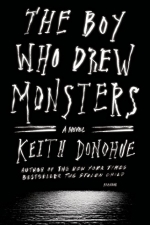
The Boy Who Drew Monsters
Book
From the New York Times bestselling author of The Stolen Child comes a hypnotic literary horror...
